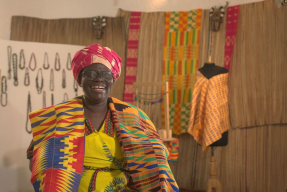By Sam Trauffer, Kyrgyzstan
Four weeks ago, I arrived in Bishkek, Kyrgyzstan, to start my second Kiva fellowship. I had spent the previous three months in Thiès, Senegal. The poverty patterns which I encountered in Senegal were not apparent in Bishkek. “Poverty in post-Soviet Union countries is not easily understood”, Eva Nemirovsky, the other Kiva Fellow who currently works in Bishkek, wrote in her recent blog post. Indeed. There seemed to be so many amenities here in Bishkek of which I would not have dared to dream of in Senegal! Four example, our apartment had a cooking stove instead of a fireplace, hot water, a functioning toilet, internet access and much more. In the streets of Bishkek there were cars which have driven only a fraction of the distances their rundown counterparts in Africa have. In short: My new environment seemed to have much more economic wealth than Senegal.
But then I learned that Kyrgyzstan is only ranked 184th in per Capita GDP, proofing the country’s weak economy (Senegal ranks only a couple of places behind Kyrgyzstan). How could this country with all its high standards be one of the poorest in the world? Taking one experience and generalizing it is almost always a bad idea. Assuming that a country’s capital represents the whole doesn’t work. This seems to be especially true in developing countries, where regional discrepancies are bigger than in the developed world, where there is not enough wealth to support the disadvantaged regions. Had I judged Senegal just from seeing its vibrant capital Dakar, I would have been similarly misled! By thinking in country-categories, we forget to consider the tremendous regional differences within each country.
The reasons for these enormous regional differences in Kyrgyzstan may be manifold: First of all, Bishkek is more accessible than other regions of Kyrgyzstan (Bishkek lies 800 Meters above sea level whereas 94 percent of Kyrgyzstan lies above 1000 meters, the average elevation being 2750 meters!). What’s more, the proximity of Bishkek to fast growing Kazakhstan further favors the capital.
How can the inequalities among the regions be addressed?
One way seems to be microfinance: The MFI—Bai-Tushum and Partners—in which I was placed is in its pilot phase with Kiva and works in all regions of Kyrgyzstan. But given the widespread poverty in remote regions it is no surprise that almost 90 percent of Bai-Tushum’s clients live in rural areas. Microfinance helps reach out to these poor people. As a lender on Kiva you can support people in these regions so that one day poverty becomes harder to find in all regions of the country, not just the capital.
















